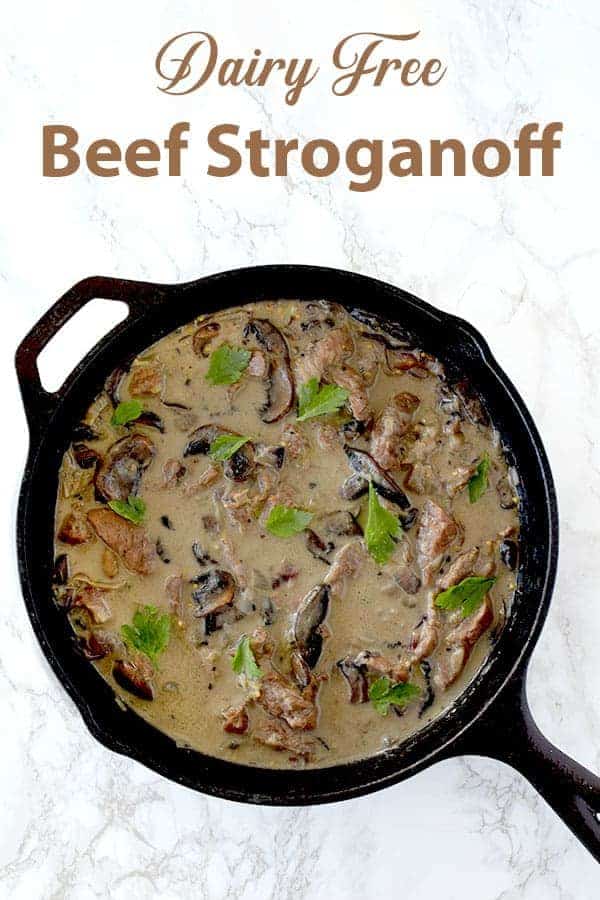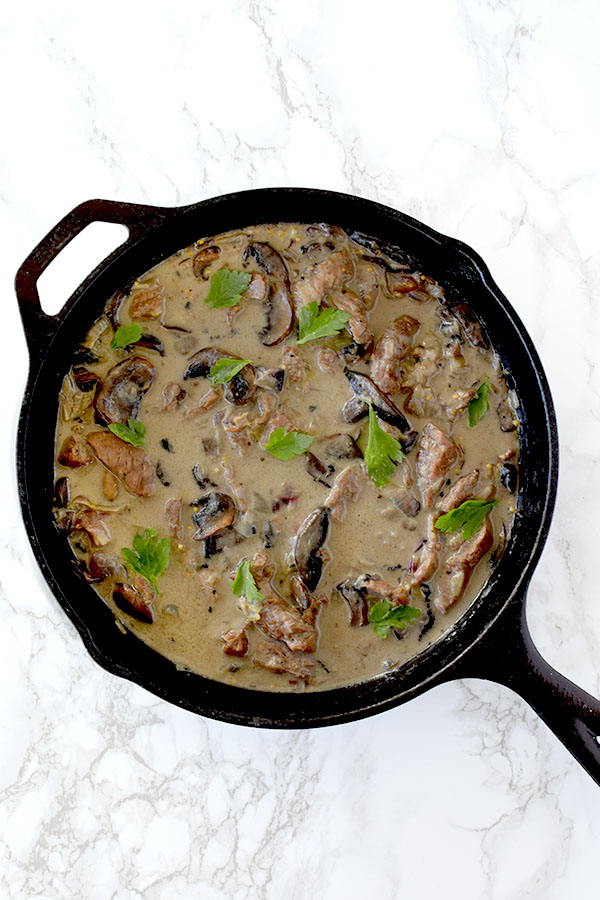Why Cant Koser Jews Eat Beef Stroganoff

Jump to Recipe
Dairy free beef stroganoff is just as rich and creamy as the classic due thanks to coconut cream. Aside from the coconut cream this recipe is completely authentic.
Serve over mashed potatoes with a dill pickle on the side as Russians do or over pasta.

Beef stroganoff was in part what inspired The Taste of Kosher.
I'd heard of the dish but never tasted it before and decided to look it up. I quickly realized that it had sour cream making it not kosher due to the restriction of cooking meat and milk together.
Then I noticed that Winchester sauce (being English) was a popular ingredient and a large clue in authentic recipes.
Now, not every recipe has to be authentic, tasty is tasty, but it being cultural cuisine was a big draw for me.
So, I was frustrated by not being able to find authentic cultural recipes made kosher. While complaining to my Mother about this she suggested I make my own site and post such recipe.
I loved the idea and had one of my friends translate a number recipes beef stroganoff so I could make it. I never like to follow just one recipe, so I usually work from a few and combine them.
Still, it took me quite a while before I got around to making it.
Russian Beef Stroganoff
While looking at the recipes I was surprised to learn that Russian beef stroganoff was different in many ways from I had seen in photos.
It was often red due to the addition of tomato paste, it never had an option for ground beef, and it was served over mashed potatoes and with a dill pickle on the side.
Looking at the recipe I also saw that it never included Worcestershire sauce. This was less of a surprise to me though since Worcestershire sauce is English where beef stroganoff is Russian.
How to eat beef stoganoff
Internationally, beef stoganoff is served over a plate of thick flat egg noodles. However, that is not actually the proper way to eat it.
In Russia it is served over potatoes or rice if you're in a pinch. It is also always served with a pickle on the side like all Russian meat dishes.
I discovered that the addition of the pickle is because in Russia, hot meat dishes are served with a pickle on the side. This solved the mystery of why a Russian friend was so often offering my pickles when we had dinner.
Following the meal, if you want to serve dessert, Russian Rogaliki with tea are just the thing!
Coconut Cream in place of Sour cream
To make this authentic Russian recipe dairy free I decided to use coconut cream instead of sour cream. At first I was a little worried that it would taste like coconut or not taste right by not having any tang.
As it turns out though, Russian sour cream is not very sour. So, the loss of sourness wasn't much of an issue.
As for the coconut flavor given by the coconut cream, didn't change the flavor. However, you should make sure to use a coconut cream that doesn't have a very strong coconut flavor. Some brands have a more distinct flavor than others.
STOCK VS. BROTH
Broth is usually thinner and made from meat, while stock is made from simmering bones for a long time.
Stock is usually thicker and has a richer mouth feel from the gelatin releases from the long-simmered bones.
Adding onions, carrots, celery, bay leaves, and other herbs add to the flavor of the stock.
WHAT ABOUT STORE-BOUGHT STOCKS AND BROTHS?
Commercial brands tend to use the terms "stock" and "broth" interchangeably and store-bought stocks and broths are usually more both then stock.
They tend to be lightly flavored and lack the body of a homemade stock and they result in a more less flavorful dish.
HOW STOCKS AND BROTHS ARE MADE
Broths and stocks are also made differently.
Stocks are typically made from meaty raw bones, leftover carcasses, and meat and vegetable scraps. In the case of vegetable stock, only vegetables are used.
Stocks are simmered for several hours (unless you make pressure cooker stocks) to extract as much of the flavor from the ingredients as possible. This also extracts collagen from the bones and cartilage, which adds body and silkiness to the stock.
Broths are usually much lighter and have less body than stocks.
They're most often made from poaching meat, vegetables, and seasonings in water for as long as it takes for the meat to cook or the broth to pick up some flavor.
HOW STOCKS AND BROTHS ARE USED
In classic French cuisine, stocks are considered to be an ingredient that's used to make other things.
Also, they're typically left unseasoned or only minimally seasoned so that they can be used in as wide a variety of ways as possible.
Stocks can be used to make soup, reduced into a sauce or a glaze, or as an ingredient in many recipes.
Broths on the other hand have been salted which restricts the ways they can be used.
For the most part, broths are consumed on its own or used as a base for soups like chicken soup.
This definition of stocks as an ingredient and broths as a food product is the way classically trained chefs tend to think about such things in their restaurant kitchens.
IS KOSHER MEAT BETTER?
Yes and no. It is not necessarily healthier as far as bacteria is concerned, since bacteria can only safely be killed with heat. What is better is the quality of the meat.
The salting process used to remove blood, as part of the koshering process, is believed to provide better quality meat. It creates a sort of quick dry brine.
Also, kosher animals are kept in better conditions than not kosher animals due to strict kosher heath requirements of the animals. They are also killed in arguably more humane conditions.
While I've only eaten kosher meat (so I cannot compare), I've been told by non-Jews who do not keep kosher that they've noticed that kosher meat is of superior quality to cook with.
SHOULD YOU WASH MEAT?
According to the USDA you should not wash chicken or meat because washing it spreads bacteria throughout the kitchen.
Water can splash bacteria up to 3 feet surrounding your sink, including onto counter tops, other food, towels and you (i.e. cross contamination).
A study done by Drexel University shows that it is best to move meat and poultry directly from package to pan. The heat from cooking will kill any bacteria that may be present.
One exception would be if there are bone fragments or residue from giblets, as in a roasting chicken. In that case, feel free to rinse if you like. However, make sure you wipe down your sink afterwards.
HOW CAN I CLEAN MY MEAT WITHOUT WASHING IT?
If you want to clean your meat without washing it, wipe it down with a wet paper towel. This will remove anything other than bacteria.
Just make sure the paper towel doesn't touch anything else and to toss the paper towel right away.
HOW TO DEFROST MEAT
IN THE FRIDGE
This method is the most highly recommended. Meat typically takes at least a full day to thaw. Once thawed, the poultry can remain in the refrigerator for a day or two before cooking.
IN COLD WATER
This should take two to three hours. Submerge your sealed meat in a pot or bowl full of cold water. Change out the water every 30 minutes or so.
Do not use warm or hot water. It is unhealthy to do so, can start cooking your meat, and doesn't do so evenly.
COOK IT FROZEN
According to the USDA, you can cook frozen meat. It will take 50% longer to cook, but it's an option. You should also cook it on a roasting rack or over vegetables so the heat can circulate around the meat.
IS IT SAFE TO REFREEZE RAW MEAT
If you have extra raw meat that you didn't use but want to refreeze, you can as long as it was thawed in the fridge.
According to the USDA "food thawed in the refrigerator is safe to refreeze without cooking." However, you do lose quality when refreezing previously defrosted meat.
Every time you defrost meat, it loses moisture through thawing which also leads to a loss in flavor. To compensate for this, marinate the meat to add more flavor and juice."
The USDA also says not to "refreeze any foods left outside the refrigerator longer than 2 hours; 1 hour in temperatures above 90 °F."
HOW TO STORE
Once cooled, place in an air tight container and refrigerate. Store for 3 to 4 days.
HOW TO FREEZE
Freeze leftovers within 3-4 days. Place in an air tight container or resealable freezer bag.
Freeze for up to 6 months. After that it is safe to eat however the quality begins to degrade.
My SNAFU:
Do not use purple onions instead of yellow onions. I did that once and the dish turned gray and we renamed it zombi stroganoff.
Prep Time 15 minutes
Total Time 15 minutes
Ingredients
- 2 tablespoons oil
- 1 yellow onion, sliced
- 8 ounces mushrooms, sliced
- 10 ounces beef steak, sliced (300 grams)*
- 1/2 cup beef stock
- 1 teaspoon whole grain mustard
- 1 cup coconut cream, unsweetened (235 milliliters)
- 2 ½ tablespoons tomato paste, optional (40 grams)
Instructions
- Heat oil in a pan and saute onions and mushrooms over medium- low heat. Remove and set aside.
- Fry beef over high heat for 3-5 minutes
- Add stock, mustard, and the cooked onions and mushrooms.
- Stir in coconut cream and optional tomato paste.
- Cover the pan with a lid, simmer until tender and soft.
- Serve over mashed potatoes or rice for an authentic dish or over egg noodles for the international version.
Notes
Another type of beef that cooks and becomes tender quickly is fine too. Russian recipes I've read usually just say beef.
Nutrition Information:
Yield:
6Serving Size:
1Amount Per Serving: Calories: 375 Total Fat: 22g Saturated Fat: 11g Trans Fat: 0g Unsaturated Fat: 9g Cholesterol: 46mg Sodium: 97mg Carbohydrates: 31g Fiber: 1g Sugar: 28g Protein: 15g
Source: https://www.thetasteofkosher.com/dairy-free-beef-stroganoff/

0 Response to "Why Cant Koser Jews Eat Beef Stroganoff"
Post a Comment